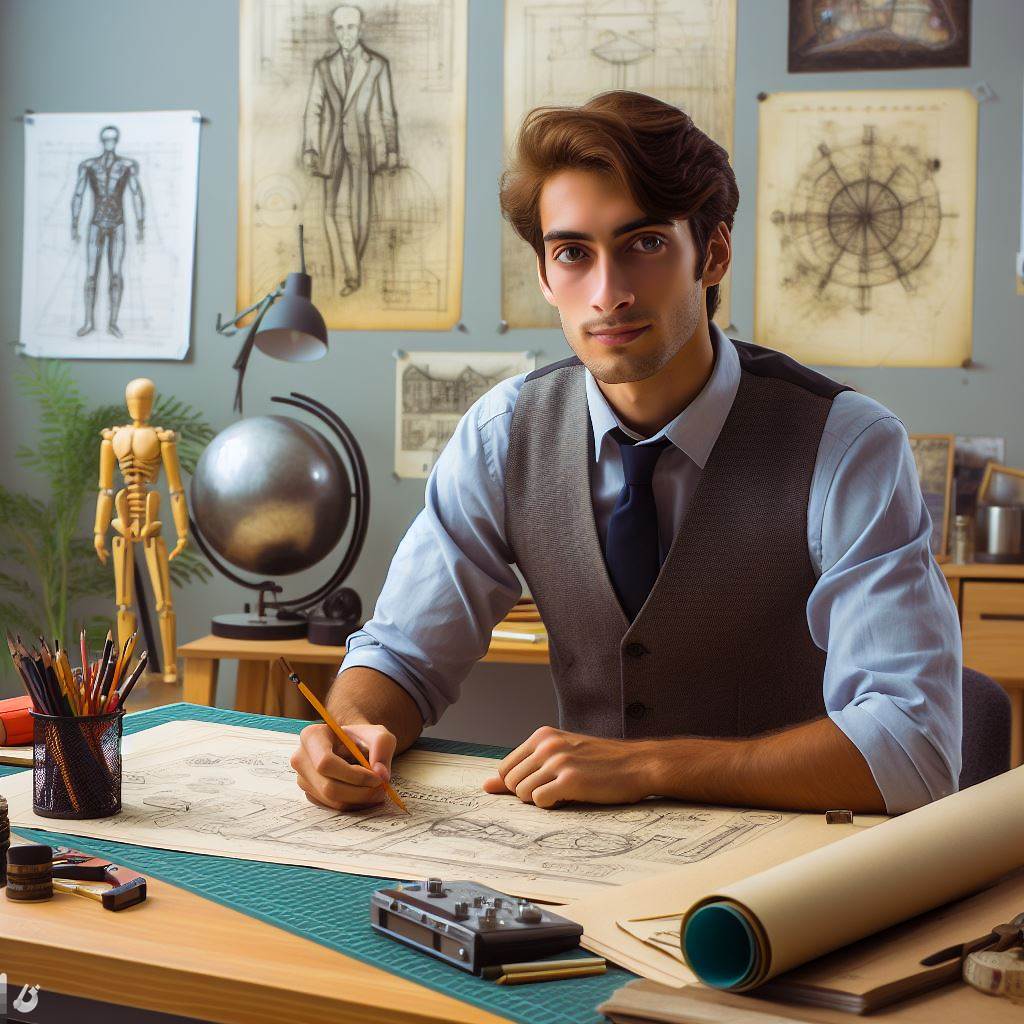Introduction
In drafting careers, balancing art and science refers to the ability to merge creativity with technical knowledge.
This balance is crucial as it allows professionals to produce visually appealing and technically accurate designs.
Without this equilibrium, drafters may struggle to effectively communicate their ideas to clients and colleagues.
The art aspect involves using imagination, aesthetics, and design principles to create visually pleasing drawings.
On the other hand, the science aspect requires technical skills, precision, and understanding of drafting software and engineering principles.
By combining these two elements, drafters can create functional and visually stunning designs that meet practical requirements.
Moreover, balancing art and science in drafting careers enhances job satisfaction and facilitates career growth.
Professionals who can effectively balance these aspects are highly valued in industries such as architecture, engineering, and manufacturing.
Employers seek individuals who can bring both creativity and technical expertise to their projects.
Ultimately, the ability to balance art and science in drafting careers is key to success in this field.
It enables drafters to produce high-quality designs that not only capture the imagination but also meet functional requirements.
As technology continues to advance, the demand for drafters skilled in both art and science will only increase.
Therefore, aspiring drafters must continually develop and refine their skills to thrive in this dynamic and evolving industry.
The Art of Drafting
Creativity and originality in drafting are crucial for success in the field. As drafters, we must strive to create unique designs that stand out from the crowd.
Our ability to think outside the box and come up with innovative solutions is what sets us apart from others.
Importance of artistic skills in creating aesthetically pleasing designs
Artistic skills play a fundamental role in creating aesthetically pleasing designs. The way we combine colors, shapes, and textures can greatly impact the overall look and feel of a project.
Without artistic sensibility, our designs may lack visual appeal, failing to capture the attention and interest of viewers.
Your Personalized Career Strategy
Unlock your potential with tailored career consulting. Get clear, actionable steps designed for your success. Start now!
Get StartedTo excel in the art of drafting, one must possess a keen eye for detail and a deep understanding of design principles.
By mastering these skills, drafters can create visually stunning and harmonious compositions that evoke emotion and engage the senses.
Examples of creative drafting techniques
There are several examples of creative drafting techniques that showcase the intersection of art and science. One such technique is the use of perspective to create depth and dimension in architectural drawings.
By applying the principles of vanishing points and foreshortening, drafters can bring their designs to life and make them more realistic.
Another creative drafting technique is the incorporation of unique patterns and motifs into textile and fashion designs.
By experimenting with different textures and shapes, drafters can create visually striking and captivating designs that grab attention.
In graphic design, the use of typography and fonts can greatly influence the overall look and feel of a project.
The careful selection of fonts that complement the design can help convey the intended message and create a cohesive visual identity.
Furthermore, the use of color theory in drafting is paramount. Understanding how colors interact and impact each other is crucial for creating visually balanced and appealing compositions.
The right color palette can evoke certain moods and emotions, enhancing the overall impact of the design.
In essence, the art of drafting requires a delicate balance between creativity and science. While technical skills and knowledge are essential, it is the artistic sensibility and creativity that truly elevate a design.
By embracing our artistic side, we can create aesthetically pleasing and visually captivating designs that leave a lasting impression.
Read: Architecture Licensing in Australia Explained
The Science of Drafting
Drafting is an art form that requires a delicate balance between creativity and scientific principles. While the artistry allows for expression and innovation, the science aspect of drafting ensures accuracy and precision.
To be successful in a drafting career, it is essential to possess technical proficiency in using drafting software and tools, have a thorough understanding of measurements and scale, and appreciate the importance of precision and accuracy.
Technical proficiency in using drafting software and tools is paramount for drafters.
These professionals must be adept at navigating computer-aided design (CAD) software, such as AutoCAD, and be familiar with various drafting tools like T-squares and drafting pencils.
Proficiency in these tools and software allows drafters to create detailed and accurate drawings efficiently.
Understanding of measurements and scale
Understanding measurements and scale is another crucial aspect of the science of drafting. Drafters must have a strong grasp of both metric and imperial units and be able to convert between them seamlessly.
Additionally, they need to understand how scale works to accurately represent real-world objects or structures on paper or digitally.
A slight miscalculation in measurements or scale can have significant consequences in the final product.
Importance of precision and accuracy in drafting
Precision and accuracy are of utmost importance in drafting.
Every line, curve, and dimension must be meticulously calculated and drawn to ensure the final product is an exact representation of the intended design.
Even the smallest deviation can result in design flaws or construction errors down the line. Drafters must pay attention to detail and constantly strive for perfection to produce high-quality and error-free drawings.
In addition to technical skills, drafters also need to possess strong problem-solving abilities and spatial awareness.
They must be able to analyze complex design problems and find practical solutions while considering various constraints.
Moreover, they should have a keen sense of space and proportion to effectively translate two-dimensional drawings into three-dimensional objects or structures.
Furthermore, familiarity with industry standards and regulations is crucial for drafters. They must stay updated on the latest building codes, manufacturing processes, and material specifications.
Adhering to these standards ensures compliance, safety, and functionality in the final design. The science of drafting requires drafters to constantly educate themselves and adapt to changes in the industry.
In general, the science of drafting involves technical proficiency, an understanding of measurements and scale, and the importance of precision and accuracy.
Drafters must possess a strong knowledge of drafting software and tools, be able to interpret measurements and scale accurately, and strive for perfection in their work.
They need to be problem solvers with spatial awareness and stay updated on industry standards. Achieving a balance between the art and science of drafting is essential for a successful and fulfilling career in this field.
Stand Out with a Resume That Gets Results
Your career is worth more than a generic template. Let us craft a resume and cover letter that showcase your unique strengths and help you secure that dream job.
Get HiredThe Synergy between Art and Science
Art and science go hand in hand in the world of drafting careers. The combination of artistic and technical skills results in high-quality drafts that are both aesthetically pleasing and precise.
How Art and Science Complement Each Other in Drafting Careers
- Visualization: Artistic skills enable drafters to envision the final product, while scientific knowledge helps them bring those ideas to reality.
- Creativity: Artistic abilities allow drafters to think outside the box and come up with innovative solutions, while scientific methods provide them with a structured approach to problem-solving.
- Attention to Detail: Art helps drafters pay attention to visual details, such as proportions and colors, while science ensures that the technical aspects are accurate and precise.
Examples of How Artistic and Technical Skills Work Together in Drafting Projects
- Architectural Drafting: Artists create visually appealing designs, while engineers provide the technical knowledge to ensure structural integrity and functionality.
- Graphic Design Drafting: Artists use their creativity to design attractive graphics, while technicians use software applications to translate those designs into digital formats.
- Industrial Drafting: Artists create concept sketches, while technicians use CAD software to develop accurate technical drawings for manufacturing purposes.
Benefits of Having a Balanced Approach in Producing High-Quality Drafts
- Enhanced Communication: A balance between art and science allows drafters to effectively convey their ideas to clients, contractors, and other project stakeholders.
- Improved Problem-Solving: The combination of artistic and technical skills equips drafters with a wider range of tools to tackle complex design challenges.
- Increased Job Opportunities: Having a balanced skill set makes drafters versatile professionals who can adapt to various industries and project types.
- Increased Client Satisfaction: A balanced approach ensures that drafts not only meet technical requirements but also exceed client expectations in terms of visual appeal.
- Greater Efficiency: Integrating art and science streamlines the drafting process, reducing the need for revisions and saving time and resources.
Generally, the synergy between art and science is crucial in drafting careers.
By combining artistic creativity and technical knowledge, drafters can produce high-quality drafts that are visually pleasing, accurate, and functional.
The benefits of a balanced approach include improved communication, problem-solving, job opportunities, client satisfaction, and overall efficiency.
Read: Challenges Faced by Modern Architects
Delve into the Subject: Internships in Civil Engineering: Aussie Guide
Challenges in Balancing Art and Science
In the world of drafting careers, professionals are constantly challenged with the task of balancing art and science.
The integration of creativity and technical knowledge can be a difficult endeavor, but one that is essential for success in this field.
- Difficulties faced in integrating creativity and technical knowledge
- Overemphasis on one aspect over the other and its negative impact on drafting careers
- Ways to overcome these challenges and find the right balance
The first challenge lies in the integration of creativity and technical knowledge.
Artistic individuals often possess a natural inclination towards creativity, while technical expertise requires a more structured and logical approach.
Finding the perfect balance between these two can be a constant struggle.
Moreover, an overemphasis on one aspect over the other can have a negative impact on drafting careers. When creativity is prioritized, technical accuracy may suffer.
On the other hand, when technical knowledge takes precedence, the final product may lack innovation and aesthetic appeal. Both extremes can limit career growth and opportunities.
To overcome these challenges, drafting professionals need to find ways to strike the right balance between art and science. Here are some strategies that can help:
Constant Learning and Skill Development
Stay updated with the latest advancements in both art and science. Attend workshops, conferences, and training programs to enhance both creative and technical skills.
Collaborate and Seek Feedback
Work alongside peers from different backgrounds to gain diverse perspectives. Engaging in collaborative projects can help blend art and science in a harmonious manner.
Seeking feedback from others can also provide valuable insights and help improve the quality of work.
Embrace Technology
Utilize drafting software and tools that combine art and science seamlessly. Technology can enhance both the creative process and technical accuracy, making it easier to find the right balance.
Cultivate a Mindset of Flexibility
Be open to new ideas and approaches. Embrace experimentation and don’t be afraid to step out of your comfort zone. Flexibility in thinking allows for the incorporation of both artistry and technical knowledge.
Seek Inspiration from Multiple Sources
Explore various art forms, attend exhibitions, and study the work of renowned artists. Draw inspiration from different industries and disciplines. This can broaden your artistic horizons and spark innovative ideas.
Find a Mentor
Connect with experienced professionals who have successfully balanced art and science in their drafting careers. Learn from their experiences and seek guidance on finding the right equilibrium.
Transform Your LinkedIn for Maximum Impact
Elevate your professional brand with a LinkedIn profile that attracts recruiters, showcases your expertise, and maximizes opportunities. Stand out in your industry with a profile built for success.
Boost ProfileEssentially, the challenges in balancing art and science in drafting careers are real but not insurmountable.
Constant learning, collaboration, embracing technology, cultivating flexibility, seeking inspiration, finding mentors—drafting professionals conquer challenges, achieving synergy between creativity and technical knowledge.
Striking this balance is crucial for a successful and fulfilling career in the drafting industry.
Read: Historic Preservation in Australian Architecture

Tips for Balancing Art and Science in Drafting Careers
When it comes to pursuing a career in drafting, finding the right balance between art and science is crucial for success.
As a draftsman, you need to be able to marry your technical knowledge with your creative abilities to produce designs that are both functional and aesthetically pleasing. Here are some tips for balancing art and science in drafting careers:
Continuous Learning and Skill Development in Both Aspects
- Stay updated with the latest advancements in drafting software and technology.
- Take courses or attend workshops to improve your technical skills.
- Learn about different design principles and art theories to enhance your creative thinking.
- Read books or articles on both art and engineering to broaden your knowledge base.
- Set aside time for practicing and experimenting with new techniques in drafting.
Seeking Inspiration from Various Sources to Nurture Creativity
- Explore different art forms, such as painting, sculpture, or photography, to get inspired.
- Visit museums, galleries, or architectural landmarks to see how different artists and designers approach their work.
- Follow influential artists, designers, or architects on social media to get a daily dose of creativity.
- Attend design conferences or networking events to learn from experts in the field.
- Find inspiration in nature, everyday objects, or cultural influences to infuse creativity into your designs.
Collaborating with Other Professionals to Gain Different Perspectives
- Work with architects, engineers, or other draftsmen on projects to understand their perspectives.
- Participate in interdisciplinary teams or design competitions to foster collaboration and exchange ideas.
- Share your work and seek feedback from peers or mentors to gain new insights.
- Join drafting or design associations to connect with professionals from various backgrounds.
- Engage in brainstorming sessions or design workshops to generate innovative solutions collectively.
In fact, striking a balance between art and science is essential for a successful drafting career.
By continuously learning and developing your skills in both aspects, seeking inspiration from various sources, and collaborating with other professionals, you can enhance your abilities as a draftsman.
Remember, it’s the combination of technical expertise and creative thinking that sets outstanding draftsmen apart.
Read: Surveying 101: An Aussie’s Intro to the Field
Conclusion
In closing, the importance of balancing art and science in drafting careers cannot be overstated. The fusion of these two disciplines allows for the creation of designs that are not only aesthetically pleasing but also structurally sound.
By embracing both the creative aspect of art and the technical aspect of science, drafters can elevate their work to new heights.
This balance enables them to push the boundaries of their creativity while adhering to the principles and practicalities of design.
While some may lean more towards the art side and others towards the science side, finding the right balance is crucial.
It is through this balance that drafters can truly excel in their field, delivering innovative designs that meet both the aesthetic and functional needs of their clients.
So, whether you are a budding drafter or an experienced professional, remember to nurture both your artistic and scientific sides. Seek opportunities to expand your knowledge in both areas and never stop learning.
By embracing the art and science in drafting, you will unlock your full potential as a draftsman, able to create designs that are not only visually stunning but also technically precise.
So, go forth and find that perfect balance—the world of drafting awaits your creativity and expertise!




